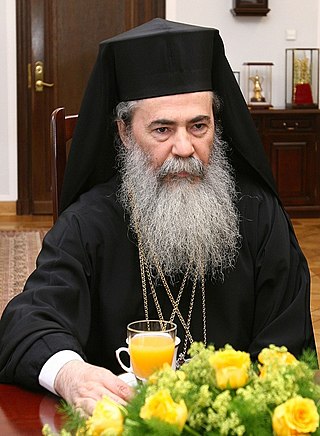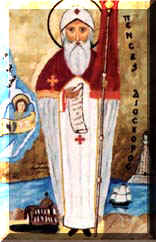| Lists of religious leaders by century: |
| See also: |
This is a list of the top-level leaders for religious groups with at least 50,000 adherents, and that led anytime from January 1, 401, to December 31, 500. It should likewise only name leaders listed on other articles and lists.
|
|
Anastasius (Latinized) or Anastasios is a masculine given name of Greek origin derived from the Greek word ἀνάστασις (anastasis) meaning "resurrection". Its female form is Anastasia. A diminutive form of Anastasios is Tassos.
The 490s decade ran from January 1, 490, to December 31, 499.

The Patriarch of Alexandria is the archbishop of Alexandria, Egypt. Historically, this office has included the designation "pope".

The Greek Orthodox patriarch of Jerusalem or Eastern Orthodox patriarch of Jerusalem, officially patriarch of Jerusalem, is the head bishop of the Greek Orthodox Patriarchate of Jerusalem, ranking fourth of nine patriarchs in the Eastern Orthodox Church. Since 2005, the Eastern Orthodox patriarch of Jerusalem has been Theophilos III. The patriarch is styled "Patriarch of the Holy City of Jerusalem and all Holy Land, Syria, beyond the Jordan River, Cana of Galilee, and Holy Zion." The patriarch is the head of the Brotherhood of the Holy Sepulchre, and the religious leader of about 130,000 Eastern Orthodox Christians in the Holy Land, most of them Palestinian Christians in Israel and Palestine.

Eutyches or Eutyches of Constantinople was a presbyter and archimandrite at Constantinople. He first came to notice in 431 at the First Council of Ephesus, for his vehement opposition to the teachings of Nestorius. At the 448 Synod of Constantinople and the 451 Council of Chalcedon, Eutyches was condemned for having adopted an equally extreme, although opposite view. He himself, however, would reject this interpretation of his thought.

Flavian, sometimes Flavian I, was Archbishop of Constantinople from 446 to 449. He is venerated as a saint by the Eastern Orthodox Church and the Catholic Church.
St. Flavian II of Antioch was the Patriarch of Antioch from 498 until his deposition and subsequent banishment in 512.
The Patriarch of Antioch is a traditional title held by the bishop of Antioch. As the traditional "overseer" of the first gentile Christian community, the position has been of prime importance in Pauline Christianity from its earliest period. This diocese is one of the few for which the names of its bishops from the apostolic beginnings have been preserved. Today five churches use the title of patriarch of Antioch: one Oriental Orthodox ; three Eastern Catholic ; and one Eastern Orthodox.
Euphemius of Constantinople was Ecumenical Patriarch of Constantinople (490–496). Theophanes calls him Euthymius. Prior to his appointment, Euphemius was a presbyter of Constantinople, administrator of a hospital for the poor at Neapolis, unsuspected of any Eutychian leanings, and is described as learned and very virtuous.

Dioscorus I, also known as Dioscorus the Great, was the pope of Alexandria and patriarch of the See of St. Mark who was deposed by the Council of Chalcedon in 451. He was recognized as patriarch by the Coptic Church until his death. He died in Gangra, Paphlagonia, in September 454. He is venerated as a saint by the Coptic and other Oriental Orthodox Churches.

Severus the Great of Antioch, also known as Severus of Gaza or the Crown of Syrians, was the Patriarch of Antioch, and head of the Syriac Orthodox Church, from 512 until his death in 538. He is venerated as a saint in the Oriental Orthodox Church, and his feast day is 8 February.
The Henotikon was a christological document issued by Byzantine emperor Zeno in 482, in an unsuccessful attempt to reconcile the differences between the supporters of the Council of Chalcedon and the council's opponents. It was followed by the Acacian schism.
The Patrologia Graeca is an edited collection of writings by the Christian Church Fathers and various secular writers, in the Greek language. It consists of 161 volumes produced in 1857–1866 by J.P. Migne's Imprimerie Catholique, Paris.
The Second Council of Ephesus was a Christological church synod in 449 convened by Emperor Theodosius II under the presidency of Pope Dioscorus I of Alexandria. It was intended to be an ecumenical council, and it is accepted as such by the miaphysite churches but was rejected by Chalcedonian Christians. It was explicitly repudiated by the next council, the Council of Chalcedon of 451, recognised as the fourth ecumenical council by Chalcedonian Christians, and it was named the Latrocinium by Pope Leo I; the Chalcedonian churches, particularly the Roman Catholic and Eastern Orthodox communions, continue to accept this designation, while the Oriental Orthodox repudiate it.
Timothy I or Timotheus I was a Christian priest who was appointed Patriarch of Constantinople by the Byzantine emperor Anastasius I in 511.
The Patriarchate of Alexandria is the office and jurisdiction of the bishop of Alexandria in Egypt, referred to since 531 as Patriarch of Alexandria. It originated from Mark the Evangelist and developed until the Council of Chalcedon in 451 when it split into parallel Chalcedonian and Miaphysite traditions, which then competed for the position for several decades before permanently parting ways in 536: